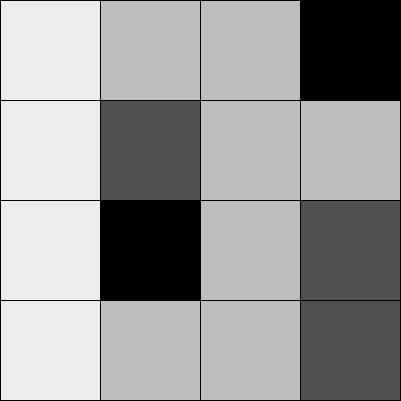Two-Dimensional Arrays
by Daniel Shiffman
This tutorial is from the book Learning Processing by Daniel Shiffman, published by Morgan Kaufmann, © 2008 Elsevier Inc. All rights reserved. If you see any errors or have comments, please let us know.
An array keeps track of multiple pieces of information in linear order, a one-dimensional list. However, the data associated with certain systems (a digital image, a board game, etc.) lives in two dimensions. To visualize this data, we need a multi-dimensional data structure, that is, a multi-dimensional array. A two-dimensional array is really nothing more than an array of arrays (a three-dimensional array is an array of arrays of arrays). Think of your dinner. You could have a one-dimensional list of everything you eat:
(lettuce, tomatoes, steak, mashed potatoes, cake, ice cream)
Or you could have a two-dimensional list of three courses, each containing two things you eat:
(lettuce, tomatoes) and (steak, mashed potatoes) and (cake, ice cream)
In the case of an array, our old-fashioned one-dimensional array looks like this:
int[] myArray = {0,1,2,3}; And a two-dimensional array looks like this:
int[][] myArray = { {0,1,2,3}, {3,2,1,0}, {3,5,6,1}, {3,8,3,4} }; For our purposes, it is better to think of the two-dimensional array as a matrix. A matrix can be thought of as a grid of numbers, arranged in rows and columns, kind of like a bingo board. We might write the two-dimensional array out as follows to illustrate this point:
int[][] myArray = { {0, 1, 2, 3}, {3, 2, 1, 0}, {3, 5, 6, 1}, {3, 8, 3, 4} }; We can use this type of data structure to encode information about an image. For example, the following grayscale image could be represented by the following array:
int[][] myArray = { {236, 189, 189, 0}, {236, 80, 189, 189}, {236, 0, 189, 80}, {236, 189, 189, 80} }; To walk through every element of a one-dimensional array, we use a for loop, that is:
int[] myArray = new int[10]; for (int i = 0; i < myArray.length; i++) { myArray[i] = 0; } For a two-dimensional array, in order to reference every element, we must use two nested loops. This gives us a counter variable for every column and every row in the matrix.
int cols = 10; int rows = 10; int[][] myArray = new int[cols][rows]; // Two nested loops allow us to visit every spot in a 2D array. // For every column I, visit every row J. for (int i = 0; i < cols; i++) { for (int j = 0; j < rows; j++) { myArray[i][j] = 0; } } For example, we might write a program using a two-dimensional array to draw a grayscale image.
size(200,200); int cols = width; int rows = height; // Declare 2D array int[][] myArray = new int[cols][rows]; // Initialize 2D array values for (int i = 0; i < cols; i++) { for (int j = 0; j < rows; j++) { myArray[i][j] = int(random(255)); } } // Draw points for (int i = 0; i < cols; i++) { for (int j = 0; j < rows; j++) { stroke(myArray[i][j]); point(i,j); } } A two-dimensional array can also be used to store objects, which is especially convenient for programming sketches that involve some sort of "grid" or "board." The following example displays a grid of Cell objects stored in a two-dimensional array. Each cell is a rectangle whose brightness oscillates from 0-255 with a sine function.
// 2D Array of objects Cell[][] grid; // Number of columns and rows in the grid int cols = 10; int rows = 10; void setup() { size(200,200); grid = new Cell[cols][rows]; for (int i = 0; i < cols; i++) { for (int j = 0; j < rows; j++) { // Initialize each object grid[i][j] = new Cell(i*20,j*20,20,20,i+j); } } } void draw() { background(0); // The counter variables i and j are also the column and row numbers and // are used as arguments to the constructor for each object in the grid. for (int i = 0; i < cols; i++) { for (int j = 0; j < rows; j++) { // Oscillate and display each object grid[i][j].oscillate(); grid[i][j].display(); } } } // A Cell object class Cell { // A cell object knows about its location in the grid // as well as its size with the variables x,y,w,h float x,y; // x,y location float w,h; // width and height float angle; // angle for oscillating brightness // Cell Constructor Cell(float tempX, float tempY, float tempW, float tempH, float tempAngle) { x = tempX; y = tempY; w = tempW; h = tempH; angle = tempAngle; } // Oscillation means increase angle void oscillate() { angle += 0.02; } void display() { stroke(255); // Color calculated using sine wave fill(127+127*sin(angle)); rect(x,y,w,h); } } 

